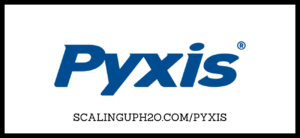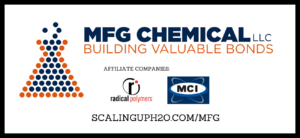 455 Mentors, Mindset, and the CWT: Owning Your Water Career with Nella Fergusson
455 Mentors, Mindset, and the CWT: Owning Your Water Career with Nella Fergusson
Scaling UP! H2O
“So one thing I never do is try to start giving remediation or advice before I truly have understood and diagnosed the problem.” Mentorship and certifications don’t replace experience—but they can accelerate it when paired with the right mindset and a disciplined approach to learning. (District Manager, Southern California, ), lays out what “growing up” in industrial water treatment actually looks like: repeated exposure to real problems, strong diagnostic habits, and a willingness to keep learning long after year one. Learning that keeps...
info_outline 454 Water Recycling, Innovation, and Industry Wisdom with Dr. Kelle Zeiher
454 Water Recycling, Innovation, and Industry Wisdom with Dr. Kelle Zeiher
Scaling UP! H2O
Industrial cooling is one of the biggest levers industrial facilities can pull on water use—and it’s getting harder to ignore as data centers and other high-heat operations grow. Returning guest (Project Manager at ) breaks down what water reuse looks like when you move past slogans and into the realities of pretreatment, concentrate management, footprint, and cost. Cooling water reuse: the scale of the opportunity Dr. Zeiher reframes “drought” beyond rainfall, emphasizing aquifer recharge and the limits of focusing only on household restrictions. She...
info_outline 453 Water Risk, Governance, and Community Engagement with Dr. Annette Davison
453 Water Risk, Governance, and Community Engagement with Dr. Annette Davison
Scaling UP! H2O
Industrial water professionals sit at the intersection of risk, regulation, and community trust. In this episode, (“the water risk doctor”) joins Trace Blackmore to show how disciplined governance, clear supply chain thinking, and community engagement can turn fragmented water systems into coherent, defensible risk management frameworks. Water risk from source to customer Annette starts with a simple question most customers never ask: “Where’s your water coming from?” She walks through a conceptual supply chain from source to end point—collection, transfer, treatment,...
info_outline 452 UV Innovation and Whole-Building Water Safety with Ron Blutrich
452 UV Innovation and Whole-Building Water Safety with Ron Blutrich
Scaling UP! H2O
Entamoeba histolytica nearly ended Ron Blutrich’s scientific career. Instead, it pushed him to rethink how we protect people in multi-family buildings, senior facilities, and dense urban centers from invisible microbiological risks in their drinking water. In this episode, he joins host Trace Blackmore to unpack what whole-building UV can (and can’t) do for Legionella, biofilm, and real-world water safety. When One Bad Cup of Water Redefines a Career In the middle of his PhD in molecular genetics, Ron drank from an under-sink reverse osmosis tap at an Airbnb and...
info_outline 451 Building a Culture of Innovation and Customer Service with Frank Lecrone
451 Building a Culture of Innovation and Customer Service with Frank Lecrone
Scaling UP! H2O
What happens when you build a company around one niche, listen obsessively to customers, and never stop improving? In this episode, host Trace Blackmore finally sits down for a full-length conversation with , Founder, President, and CEO of . What started in a small 60' x 60' space in Hanover, Pennsylvania, with three employees, maxed-out credit cards, and endless Staples runs has grown into a 300+-person organization serving industrial water professionals around the world. Frank shares how AquaPhoenix became “the booth everyone wants to be next to” at...
info_outline 450 Wastewater Advocacy and Innovation with Robin Deal
450 Wastewater Advocacy and Innovation with Robin Deal
Scaling UP! H2O
“The More You Know” - Robin Deal A million-gallon-a-day perspective, distilled into actionable steps. , AquaPure Product Manager at unpacks how seasoned pros can squeeze more performance—and less sludge—out of industrial wastewater systems without compromising compliance or plant uptime. From “clear water in a jar” to stable discharge in the field Robin details a practical jar-testing workflow: start from upstream processes, target pH using hydroxide/sulfide solubility curves, choose the right coagulant (aluminum, iron, calcium, lanthanum, or organics),...
info_outline 449 Michael Bourgeois on AWT Partnerships and Professional Growth
449 Michael Bourgeois on AWT Partnerships and Professional Growth
Scaling UP! H2O
Get stuck in – Michael Bourgeois, CWT How do standards get written in ways that working water treaters can actually meet? In this conversation, AWT Past President, current Related Trade Organization (RTO) Committee Chair, and Chemco Products Company Operations Manager, , explains how AWT’s liaisons collaborate with peer organizations, so guidance reflects field reality—operations, risk, and achievable compliance. From Field Bags to Board Rooms: Why RTOs Matter Bourgeois outlines the purpose of AWT’s RTO structure: volunteer liaisons track and influence work at groups...
info_outline 448 2025 Halloween Special
448 2025 Halloween Special
Scaling UP! H2O
Holidays don’t usually line up with release day—but this year they did. In this Halloween special, Trace uses the horror-movie trope of the “scary boiler room” to deliver practical, field-tested reminders for safer sampling, clearer thinking, and better decisions in high-heat, low-light spaces. Boiler Rooms, Myths, and Real Risks From Nightmare on Elm Street to Tower of Terror, pop culture loves dim steam, tight corridors, and clangy pipe-labyrinths. Trace contrasts that imagery with what matters to pros: light, ventilation, a stable work surface, and time for...
info_outline 447 Unlocking Team Potential with Culture Index with Randi Fargen
447 Unlocking Team Potential with Culture Index with Randi Fargen
Scaling UP! H2O
Hiring in industrial water is slow, specialized, and expensive to get wrong. In this conversation, executive advisor explains how a two-question, 5–7 minute Culture Index survey becomes an ongoing management and coaching system—not just a hiring screen—so owners cut turnover risk, speed onboarding, and improve day-to-day communication. From “assessment fatigue” to a usable language Most teams dread long assessments. This survey takes minutes and measures four primary traits—autonomy, sociability, pace/patience, conformity—plus three...
info_outline 446 Leveraging the Culture Index for Business Success with Danielle Scimeca and Conor Parrish
446 Leveraging the Culture Index for Business Success with Danielle Scimeca and Conor Parrish
Scaling UP! H2O
How do you make “right person, right seat” a repeatable system—not a hope? ’s (President) and returning guest (Chief Growth Officer) share how the Culture Index became a decisive tool for coaching, hiring, and a company-wide restructure. If you lead field service, customer service, or operations in industrial water, this conversation offers practical patterns you can apply the next time a role feels misaligned or a 1:1 stall on surface-level updates. From intuition to instrumentation Trace opens with the origin story and quickly moves to why Danielle and Conor adopted...
info_outline
Wastewater isn’t an endpoint—it’s a decision point. On Wastewater Thursday, host Trace Blackmore, CWT sharpens the operator’s toolkit with field-tested lessons: dose by mechanism, verify by sampling discipline, and use wastewater’s fast feedback to protect quality, cost, and permits.
Sampling discipline protects credibility
Trace recounts an early-career moment when an inspector sampled the wrong location, triggering alarms. Immediate, methodical resampling—guided by logs and a clear process map—proved the system was in spec. The leadership takeaway: embed verification before escalation. Clear sampling points, time-stamped logs, and a rapid “reproduce the reading” drill turn uncertainty into clarity.
Mechanism over myth: coagulant control
In a new Detective H2O case, James McDonald explains why overfeeding coagulant collapses floc. When particles swing past neutral, like charges repel again and settling stalls. The fix is not “more chemistry,” but right-sizing dose to production and confirming with jar tests at the correct take-off point.
From discharge to resource
Greetings from past guests reinforce the shift under way. Arnaud Valleteau de Moulliac (Veolia Water Technology) frames wastewater as a local, decarbonized resource—with energy-positive plants and reuse as standard practice. Steve Russell (Kiewit) notes supply pressure will push even deeper recycling. Mark Lewis, CWT (Southeastern Laboratories) underscores wastewater’s advantage: “If you treat it, you see it.”
Make wastewater a reliable, fast-feedback control loop—rooted in charge balance, sampling rigor, and reuse thinking.
Listen to the full conversation above. Explore related episodes below. Stay engaged, keep learning, and continue scaling up your knowledge!
Timestamps:
02:17 — Welcome to Wastewater Thursday and the IWW25 theme: “From foundations to futures.”
03:03 — Why wastewater is “the restart”: cleaning for reuse and sustainability.
04:24 — “Every drop counts from influent to effluent” — defining the professional mandate.
05:12 — Field story setup: jar testing with Trace’s father; early lessons.
06:05 — Crisis call: bad regulatory number traced to wrong sampling location.
08:54 — Guest greeting: Arnaud Valleteau de Moulliac (Veolia) on energy-positive, reuse-driven futures.
10:25 — Guest greeting: Steve Russell (Kiewit) on permits, mass balances, and supply-driven recycling.
12:09 — Guest greeting: Mark Lewis, CWT (Southeastern Laboratories) on jar tests and product selection.
14:40 — Detective H2O: The case of too much of a good thing
20:17 — Mechanism lesson: charge neutralization window; like-charge repulsion returns when overdosed.
21:36 — Action: reduce dose; account for residence time; restore performance.
24:29 — IWW25 community prompt: post a safety-approved photo with wastewater equipment; use tags.
Connect with Mark Lewis
Phone: 704.322.5406
Email: MLewis@SELaboratories.com
Website: https://www.selaboratories.com/
LinkedIn: linkedin.com/in/mark-lewis-01a3b56
Connect with Steve Russell
Phone: 913.689.4533
Email: steve.russell@kiewit.com
Website: https://www.kiewit.com/
LinkedIn: https://www.linkedin.com/in/steve-russell-2b0a7960/
Connect with Arnaud Valleteau de Moulliac
Email: arnaud.valleteau@veolia.com
Website: www.veoliawatertechnologies.com
LinkedIn: linkedin.com/in/arnaud-valleteau-de-moulliac-9b85353a/
www.linkedin.com/company/veolia-water-technologies/
Links Mentioned
AWT (Association of Water Technologies)
Scaling UP! H2O Academy video courses
034 The Other One With Mark Lewis, CWT
112 The One Where Trace Is Interviewed By Mark Lewis
141 The One About Neglected Accounts
149 The One About Some of the Lesser-Used Technologies
382 Leading with Safety: How Veolia Embeds Health into Global Culture
396 Navigating Carbon Capture: Water Demands and Wastewater Solutions with Steve Russell
404 Eight Tips for Business Management: Part 1 – Essential Strategies
406 Eight Tips for Business Management: Part 2 – Essential Strategies



